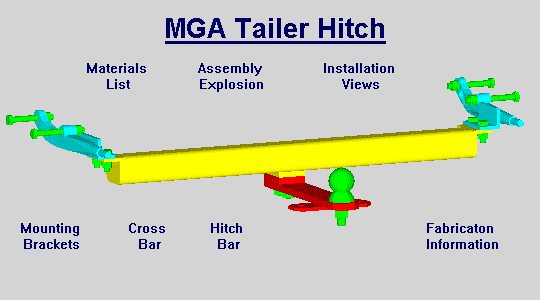The MGA With An Attitude
The MGA with an attitude presents you with the design for a full Class-I trailer hitch for the MGA. It is structurally designed to handle a 2000 pound tow load and a 200 pound tongue load. Yeah, like it could actually tow that sort of a load? For safety and handling reasons, it would be prudent to limit the tongue load to 100 pounds maximum. And a more practical towing capacity for the car itself would be more like 600 to 700 pounds for regular use, although you could hook up another MG in a pinch. If you were towing 2000 pounds at speed and hit the brakes hard, the hitch would hold up to the load just fine, the car tires would probably skid on the road, and hopefully you wouldn't jackknife the rig. For any load approaching 1000 pounds, the towed vehicle should be equipped with brakes. For trailers without brakes, the driver must allow plenty of room ahead for the extra braking distance as required. Pick a label in the picture below to view the associated document.
Description In Brief: The main structural cross member is a 2 inch square 1/4 inch thick steel tube. Angle iron is welded to the ends of the tube, and another piece of angle iron is welded to the rear original forged bumper mounting brackets at each side. The angle brackets are bolted together with two 1/2" bolts at each side so the whole assembly can be removed from the car, except for the last welded angle on the bumper bracket. Even there it could be returned to original form by replacing the bumper brackets, or the hitch assembly could be transferred to another car in the same manner. On the bottom of the cross tube there is a 1/2 inch thick plate welded in place, and that plate (and the tube) is drilled and tapped to accept two 5/8" bolts. At this point the hitch extension piece can be removed to be stowed in the boot or hidden away elsewhere. With the hitch extension removed, the rest of the hitch assembly is nicely hidden inside the rear valence of the car body, completely out of sight, unless you were to lie on your back to look up from underneath. Check out the installation views to see why it is so well hidden. |
